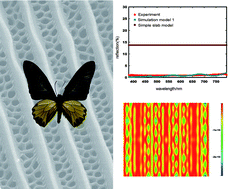Read the article for free until 23 February>>
Scientists from China have conducted studies to model the antireflective behaviours of butterfly scales in an attempt to understand the blackness of butterfly wings.
By examining effective solar collection systems found in nature, the team hopes to find inspiration for designing solar cells, sunlight splitting water reactors, anti-reflection films in lenses, micro-optical sensors, stealth technology, photocatalysis, as well as other artificial systems that require efficient light harvesting.
The team found that the blackness of the scales is a result of the coupling effect of physical and chemical factors. The nanostructure of the scales acts as the physical element and enhances light harvesting by reducing reflection when light enters the structured scales. Then, the melanin distributed in the bottom part of the scales chemically absorbs incident light and energy is transferred to the electrons of the pigment melanin. The physics and chemistry mutually assist each other to give maximum light absorption of the butterfly scales, generating the ultra-black effect.
Art of blackness in butterfly wings as natural solar collector
Qibin Zhao, Xingmei Guo, Tongxiang Fan, Jian Ding, Di Zhang and Qixin Guo
Soft Matter, 2011, 7, 11433-11439
DOI: 10.1039/C1SM06167D
To keep up-to-date with all the latest research, sign up for the Soft Matter e-Alert or RSS feeds or follow Soft Matter on Twitter or Facebook.











